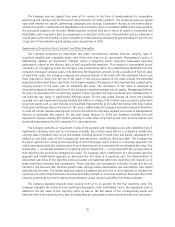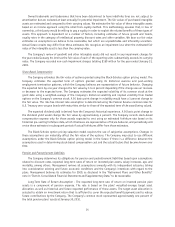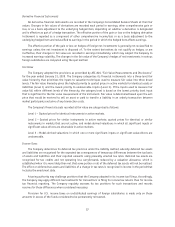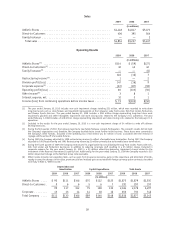Foot Locker 2009 Annual Report Download - page 51
Download and view the complete annual report
Please find page 51 of the 2009 Foot Locker annual report below. You can navigate through the pages in the report by either clicking on the pages listed below, or by using the keyword search tool below to find specific information within the annual report.NOTES TO CONSOLIDATED FINANCIAL STATEMENTS
1. Summary of Significant Accounting Policies
Basis of Presentation
The consolidated financial statements include the accounts of Foot Locker, Inc. and its domestic and
international subsidiaries (the ‘‘Company’’), all of which are wholly owned. All significant intercompany amounts
have been eliminated. The preparation of financial statements in conformity with U.S. generally accepted
accounting principles (‘‘GAAP’’) requires management to make estimates and assumptions relating to the
reporting of assets and liabilities and the disclosure of contingent liabilities at the date of the financial
statements, and the reported amounts of revenues and expenses during the reporting period. Actual results may
differ from those estimates.
In July of 2009, the Company adopted the FASB Accounting Standards Codification (‘‘ASC’’ and collectively,
the ‘‘Codification’’), which establishes the Codification as the source of authoritative accounting principles
recognized by the FASB to be applied by nongovernmental entities in the preparation of financial statements in
conformity with GAAP. The historical GAAP hierarchy was eliminated and the Codification became the only level
of authoritative GAAP, other than guidance issued by the SEC. The FASB will not issue new standards in the form
of Statements, FASB Staff Positions or Emerging Issues Task Force Abstracts. Instead, it will issue Accounting
Standards Updates (‘‘ASUs’’). ASUs will serve to update the Codification, provide background information about
the guidance and provide the basis for conclusions on changes in the Codification. The Codification was effective
for all financial statements issued for interim and annual periods ending after September 15, 2009. Accordingly,
the Company has reflected all necessary changes in this filing.
Reporting Year
The reporting period for the Company is the Saturday closest to the last day in January. Fiscal years 2009,
2008 and 2007 represent the 52 week periods ending January 30, 2010, January 31, 2009 and February 2, 2008,
respectively. References to years in this annual report relate to fiscal years rather than calendar years.
Revenue Recognition
Revenue from retail stores is recognized at the point of sale when the product is delivered to customers.
Internet and catalog sales revenue is recognized upon estimated receipt by the customer. Sales include shipping
and handling fees for all periods presented. Sales include merchandise, net of returns, and exclude taxes. The
Company provides for estimated returns based on return history and sales levels. Revenue from layaway sales is
recognized when the customer receives the product, rather than when the initial deposit is paid.
Gift Cards
The Company sells gift cards to its customers, which do not have expiration dates. Revenue from gift card
sales is recorded when the gift cards are redeemed or when the likelihood of the gift card being redeemed by the
customer is remote and there is no legal obligation to remit the value of unredeemed gift cards to the relevant
jurisdictions. The Company has determined its gift card breakage rate based upon historical redemption patterns.
Historical experience indicates that after 12 months the likelihood of redemption is deemed to be remote. Gift
card breakage income is included in selling, general and administrative expenses and totaled $4 million,
$5 million, and $4 million in 2009, 2008, and 2007, respectively. Unredeemed gift cards are recorded as a current
liability.
Statement of Cash Flows
The Company has selected to present the operations of the discontinued businesses as one line in the
Consolidated Statements of Cash Flows. For all the periods presented this caption includes only operating
activities.
Store Pre-Opening and Closing Costs
Store pre-opening costs are charged to expense as incurred. In the event a store is closed before its lease
has expired, the estimated post-closing lease exit costs, less the sublease rental income, is provided for once the
store ceases to be used.
33
























